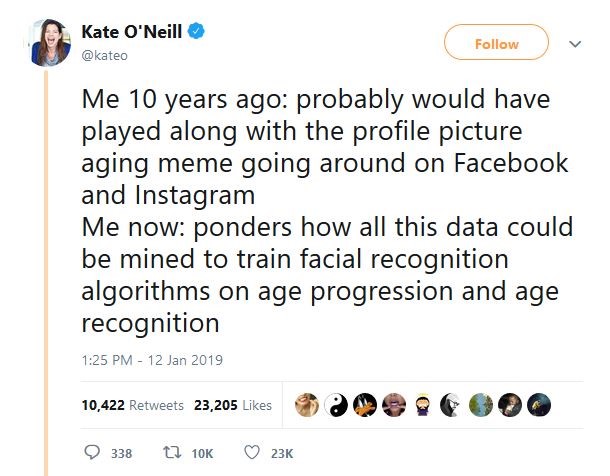Social media users are generating millions of publicly shared photos comparing themselves in 2009 and 2019. In addition to generating likes and comments on posts, the popular “10 Year Challenge”, most prominently featured on Facebook, is also providing social networking companies and researchers organized data sets regarding what you looked like ten years ago and what you look like now. The challenge offers insight into how our personal data can be solicited and used against social media users.
Kate O’Neil, founder of KO Insights, tweeted her response to the challenge bringing up similar concerns and found it resonated with other social media users.

In her recent opinion piece on Wired.com O’Neil expresses the need for the public’s heightened awareness of the implications of sharing something as seemingly innocent as a meme.
“Imagine that you wanted to train a facial recognition algorithm on age-related characteristics and, more specifically, on age progression (e.g., how people are likely to look as they get older). Ideally, you’d want a broad and rigorous dataset with lots of people’s pictures. It would help if you knew they were taken a fixed number of years apart—say, 10 years.
“We must all become savvier about the data we create and share, the access we grant to it, and the implications for its use.”
Sure, you could mine Facebook for profile pictures and look at posting dates or EXIF data. But that whole set of profile pictures could end up generating a lot of useless noise. People don’t reliably upload pictures in chronological order, and it’s not uncommon for users to post pictures of something other than themselves as a profile picture. A quick glance through my Facebook friends’ profile pictures shows a friend’s dog who just died, several cartoons, word images, abstract patterns, and more.
In other words, it would help if you had a clean, simple, helpfully labeled set of then-and-now photos…”
– Kate O’Neil, Wired.com
While companies like Facebook, Twitter, and Instagram scrub data from images once they’ve been uploaded to their sites, the initial metadata they receive from uploaded photos is always available to them. In other words, Facebook has access to details from your photo including geo coordinates, time of capture, location/time of posting, and much more. O’Neil’s concern is a valid one: that data mined from posts like these memes could be used to train facial recognition algorithms on age progression and recognition.
However, the viral phenomenon is also simply indicative of a larger trend of underestimating the permanence of uploaded data. According to Prescient’s Cyber Lead, Max P., “Social media and the share all culture of today has given individuals a substantial glimpse into the formerly personal lives of their networks, for better or worse. The collateral damage of being socially and technologically trendy is the devaluation of personal privacy. The same social media feed that non-malicious members of one’s network are privy to can also be pulled by the likes of cyber criminals, hackers, and other nefarious actors.”
